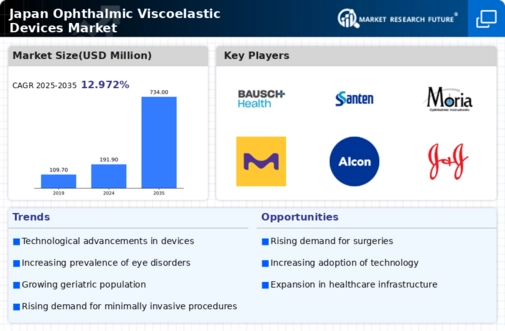The Japan Ophthalmic Viscoelastic Devices Market is characterized by growing competition among various key players that are persistently striving to enhance their product offerings and expand their market share.
The market landscape is influenced by advancements in technology, the increasing prevalence of eye disorders, and a rising number of cataract surgeries, which contribute to the demand for ophthalmic viscoelastic devices. The competitive dynamics in this market are shaped by both local and international manufacturers, who are focusing on research and development to innovate and improve the efficacy and safety profiles of their products.
As the market evolves, companies are increasingly forming strategic partnerships and collaborations to leverage their strengths and enhance their competitive position while addressing the needs of healthcare professionals and patients alike.
Oculentis stands out in the Japan Ophthalmic Viscoelastic Devices Market with its strong brand reputation and commitment to quality. The company focuses on providing high-performance viscoelastic solutions that cater to a variety of surgical needs during cataract procedures. Oculentis possesses a distinguished ability to blend innovation with efficiency, which has garnered trust among ophthalmic surgeons and healthcare providers in Japan.
The company ensures that its products not only meet but exceed regulatory requirements, contributing significantly to its robust market presence. With a dedicated approach to customer education and a consistent effort to gather feedback for product improvements, Oculentis has solidified its position as a prominent player in this competitive landscape, characterized by a heightened focus on surgical outcomes and patient satisfaction.Surfacematch has established a notable presence in the Japan Ophthalmic Viscoelastic Devices Market, primarily recognized for its innovative approach to viscoelastic products designed for ophthalmic surgeries.
The company provides a range of specialized devices that enhance surgical precision and patient outcomes. Surfacematch's strengths lie in its commitment to research and development, leading to the introduction of new and improved formulations that cater specifically to the needs of ophthalmic surgeons in Japan. The company emphasizes strategic collaborations and partnerships, which not only enhance its product portfolio but also widen its reach in the market.
This strategy has proven effective in positioning Surfacematch as a competitive player amidst the evolving demands of the ophthalmic device segment. Additionally, the company is actively pursuing mergers and acquisitions to bolster its capacity for innovation and expand its market footprint in Japan, aligning with the increasing trends in minimally invasive surgical techniques and personalized patient care.


















Leave a Comment